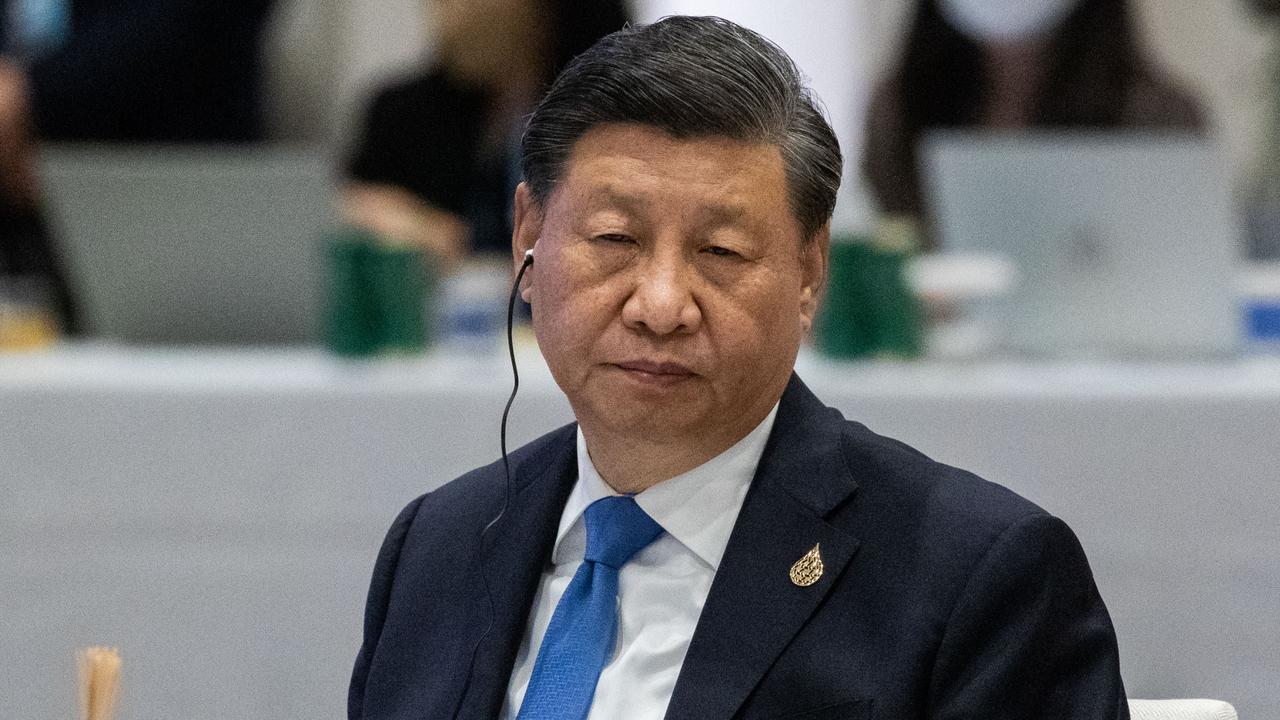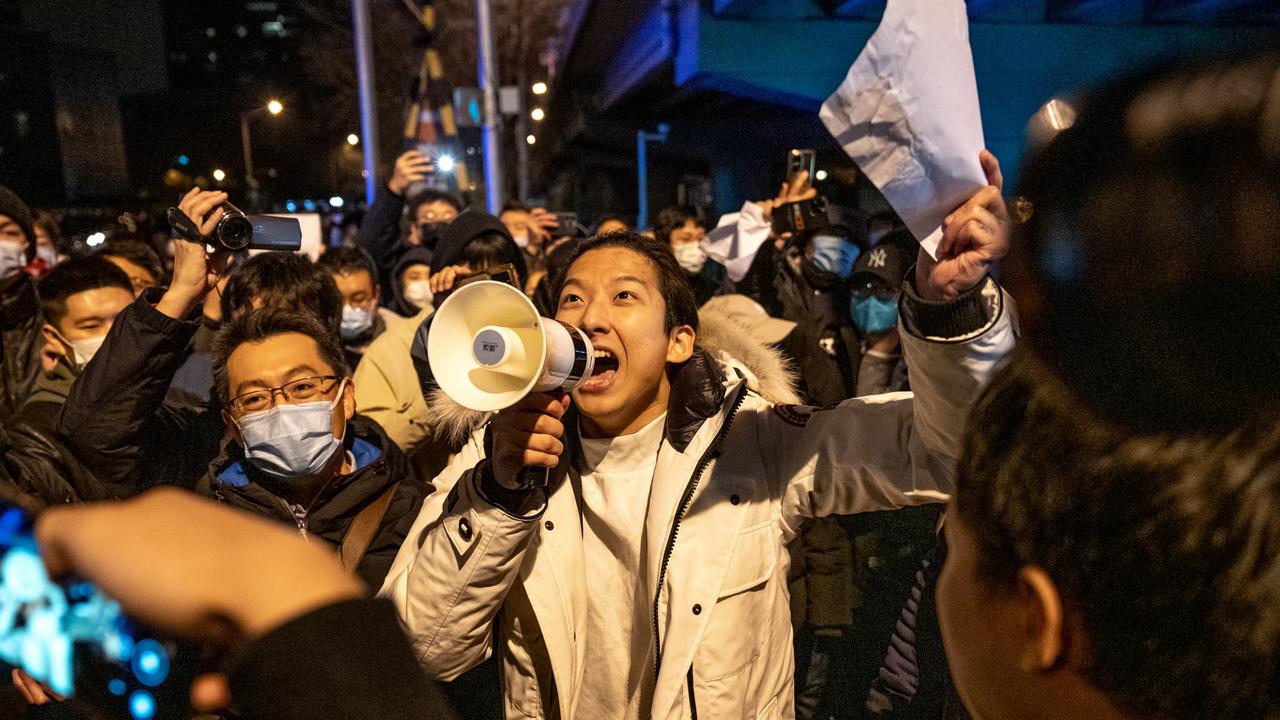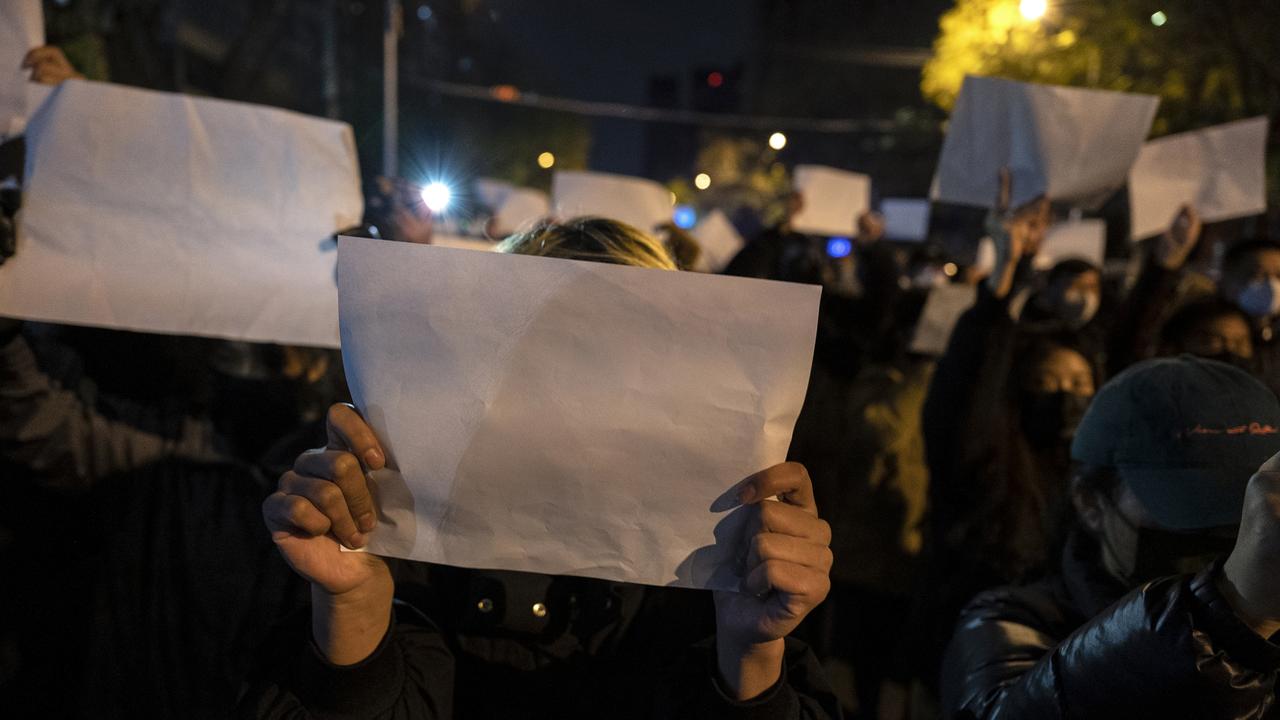China’s chilling response to rare protests
Chinese protesters are rising up against Covid zero but the response by Beijing is a terrifying sign of things to come.
Face-recognition software is identifying protesters. Mobile phones are being tracked to marches, and social media scoured for clues.
Beijing is unleashing everything in its dystopian arsenal to smother any repeat of last weekend’s Covid lockdown protests.
China’s vast security machine is in high gear.
Protest sites are sealed off. Police are patrolling the streets. People are being stopped at random to have their mobile phones checked. Others are getting phone calls and knocks on their door by authorities warning them against further action.
On Wednesday, China’s domestic security chief vowed to “effectively maintain overall social stability”. And his overwhelming display of intimidation appears to be working.
Last weekend saw at least 23 demonstrations across 17 cities.
They appeared to have been sparked by the deaths of 10 people in an apartment building fire under Covid-19 lockdown.
Protesters took to the streets.
There is some speculation on how the state will respond to recent contentious events in China. The state conceptualizes these as "sudden public incidents" çªå‘公共事件. Detailed contingency plans exist at every level, instructing authorities how they should respond. A brief 🧵
— Christoph Steinhardt (@hcsteinhardt) November 27, 2022
They carried candles, flowers – and blank pieces of paper – in Shanghai, Beijing, Chengdu, and Guangzhou, among others. They chanted, “we want freedom”. Also, “Xi Jinping, step down”.
That’s where the protesters crossed the Chinese Communist Party’s “red line”.
They can complain about specifics. They can criticise the local implementation of policy. But they can’t criticise policy – or the Party – itself.
The CCP’s response initially appeared slow. The protests – usually of just a few hundred to a thousand people – were mainly left unhindered. And the firestorm of social media posts supporting their stance flashed throughout Chinese social media.
That seems odd.
A demonstrator on Sitong Bridge in Beijing during the 20th National Congress last month was quickly detained and his signs torn down. And all mention of the protest was quickly erased.
But participants, supporters and innocent bystanders of last weekend’s events have felt the fallout ever since.

All-seeing eye
China’s Central Political and Legal Affairs Commission said on Wednesday that it was “necessary to crack down on infiltration and sabotage activities by hostile forces in accordance with the law”. It would “resolutely strike hard against infiltration and sabotage activities by hostile forces, as well as illegal and criminal acts that disrupt social order”.
Doorknocks. Phone calls. Seized mobile phones. These are the tools China’s security apparatus is using to quell unrest.
The Chinese officials used implicit language, but they also conveyed a clear message of warning. The protesters must have understood it. If they repeat those protests, the risks will increase severely. pic.twitter.com/X04MJxXuNh
— Hu Xijin 胡锡进 (@HuXijin_GT) November 29, 2022
They’re acting on information gleaned from an overwhelming array of security cameras linked to facial – and body posture recognition systems. Not to mention the regular “handshakes” mobile phones make with relay towers as they move into range.
And Party censors have been scouring Chinese and Western social media accounts to track who was responsible for sharing the news.
Put simply, everyone at, near, or commenting about a street protest is being traced.
“I wasn’t stopped on the street. I suspect the police may have detected that I’ve been using Telegram,” one Shanghai resident told German news service DW.
“I received two separate calls from the police, warning me not to share anything about the pandemic or the protests. My father also received a threatening call from them.”
#China cyber watchdog announces new rule: liking an online post is defined as commenting as of Dec 15. Chinese media interpret rule change to mean those liking a post deemed as “harmful information†can also be held responsible for the original comment. https://t.co/RWutAD5bul
— Eunice Yoon (@onlyyoontv) November 28, 2022
“One reasonable suspicion is that the police may have used surveillance technology to determine the location of protesters’ phones at a specific place and at a specific time,” another resident said.
A week on, few signs of protest remain evident.
“Given Beijing’s powerful tools of surveillance and control, it seems unlikely that these events pose a direct threat to the regime,” writes Council on Foreign Relations China analyst Ian Johnson. “But in challenging the government, the protests have raised far-reaching questions about how Xi’s second decade in power will play out.”


Evolve, or die
Protests happen in China all the time. It’s just that they often occur in a very indirect or formalised manner. And local Communist Party leaders are usually quick to do what they can to diffuse the situation.
Problems only arise when the central government in Beijing is implicated.
Similar pandemic-related protests began as soon as the virus spread in Wuhan in 2020, and lockdowns began to be strictly applied. These did not target Beijing’s policies. Instead, they attacked their local implementation – such as the failure to deliver groceries or medical care.
In that way, they didn’t cross the CCP’s “red line”.
Protests took place in many places in China over the past weekend. With the relaxation of the epidemic prevention and control measures, public sentiment will soon calm down. I can give an absolute prediction: China will not become chaotic or out of control.
— Hu Xijin 胡锡进 (@HuXijin_GT) November 28, 2022
But, almost three years later, the population’s patience ran out.
“The repeated cycles of easing and tightening, caging people like lab rats, finally wore through the last of people’s patience,” writes Chinese scholar Deng Yuwen.
Guangzhou has announced lifting of all lockdowns. Beijing has been gradually lifting lockdowns over the past few days. Vice Premier Sun Chunlan on Wed formally noted the virus' weakening pathogenicity for the first time...China is speeding up to cast aside large-scale lockdowns.
— Hu Xijin 胡锡进 (@HuXijin_GT) December 1, 2022
“Under the government’s zero-Covid policies, everyone knows that they could be the next to suffer – including people inside the system, particularly officials and workers on the front lines of pandemic response, many of whom have long since burned out from exhaustion and overwork. Everybody wants a change – but as long as Xi does not, they will have no choice but to endure.”
Beijing’s reaction appears mixed.
On Monday, Chinese Foreign Ministry spokesperson Zhao Lijian was asked if China would ease zero-Covid policies due to the protests.
“What you mentioned does not reflect what actually happened,” he replied.
On Thursday, Chinese Vice Premier Sun Chunlan appeared to change tack.
Compare Sun's characterization with heavyweight official media editorials in October. https://t.co/mJiB3p9otW
— Yang Liu (@yangliuxh) December 1, 2022
“With the decreasing toxicity of the Omicron variant, the increasing vaccination rate and the accumulating experience of outbreak control and prevention, China’s pandemic containment faces a new stage and mission,” he said.
Shortly after, 24 “high-risk” Shanghai districts had their lockdowns removed.
In November, 412 million Chinese were affected by one level or another of the Covid-19 lockdown policy. On Wednesday, the country recorded 36,000 cases – one of the highest levels since the pandemic began.
Jamie Seidel is a freelance writer | @JamieSeidel






